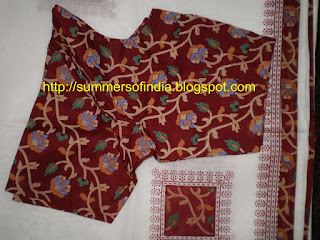Here I am once again with some more batik. But this time its from my own state Andhra Pardesh. This was done on a very fine cotton. These days many women are learning various arts and skills and setting up their own units, earning well and standing up on their feet. Specially, block printing, tie and die batik, fabric painting, embroidery on saris and dresses are one of the many vocations they are choosing. This not only gives them to practise their creativity but also helps in earning handsomely.
I happened to pick this one up for my mother. the combination is dark pink with green pallu and borders. This can be starched but is very comfortable without in summer when it is unbearably hot. Its also very soft.
Just see the designs....
These are the designs on the green pallu...











This is on the bottom of the sari like a border

These are the butties allover the sari


This is the contrasting green pallu for a dark pink sari....

I happened to pick this one up for my mother. the combination is dark pink with green pallu and borders. This can be starched but is very comfortable without in summer when it is unbearably hot. Its also very soft.
Just see the designs....
These are the designs on the green pallu...











This is on the bottom of the sari like a border

These are the butties allover the sari


This is the contrasting green pallu for a dark pink sari....

How do you like these simple designs?












































